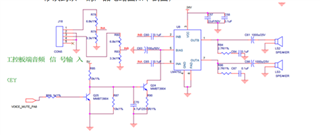2. The product circuit diagram related to the IC is as follows:,
Please analyze the defects of this batch of IC to confirm whether this batch of IC can continue to be used?



This thread has been locked.
If you have a related question, please click the "Ask a related question" button in the top right corner. The newly created question will be automatically linked to this question.



Hi Suzhen,
Have you submitted this through quality analysis?
Were the 200 units from different lots but only the 3 damaged ones?
What is the test you're running while the devices are getting damaged?
Best regards,
-Ivan Salazar
Applications Engineer
1.yes.they reply me that :TI has reviewed this request. Based on the reported symptom(s), it has been determined that the device has experienced EIPD - Electrically Induced Physical Damage. TI has confirmed that all units received 100% electrical testing before shipment to customers. EIPD/EOS damage that occurred at TI is judged to be unlikely. TI does not consider further analysis of the sample. This device has no customer return in recent several years, very old history return had one time pin short and FA confirmed EOS damage/EIPD, the FA can only tell the EOS damage result but can't tell the EOS root cause/source. Suggest check which pin short, test pin voltage waveforms during power on/off and testing, then check with TI FAE or E2E for application and test review for EOS risk see if any transient over-voltage spike exceeding TI maximum rating spec.
2. 200units are same lots .At present, only 3 pieces are damaged, but worried about product quality problems, other equipment are afraid to use at present.
3.Damaged when power on.Our equipment has been tested for static electricity. It's ok if we've been tested for static electricity.
4.New case :There is a bad case in the same batch today(lot is also the same as the 3 pieces before): one interface on the same chip suddenly has no sound, and the other interface is OK
Hi Suzhen,
I'll check in the QA reports for further details on the analysis and debug, will try to get further comments on the second half of this week.
Best regards,
-Ivan Salazar
Applications Engineer
Thank you for your help!
In addition, we have doubts about their judgment that it is the result of EOS. Even EOS hopes to provide analysis reports. If you have any questions, you can contact me KXECBOBO@OUTLOOK.COM
Hi Suzhen,
Have you tested continuity between the pins to identify which ones are damaged? You can compare the continuity results between a good unit vs a damaged one. I wonder if the mute circuit on Bias pin could be related, it is not the exact same as the data sheet suggestion, perhaps the mute transition is too fast a transient at the input DC level is then amplified and potentially causing EOS at the outputs.
Don't think we can comment much more other than this, the history of this device does not show any other quality claim back to several years.
I cannot comment on the decision taken to decline the analysis, it seems it was considered that part was damaged due to EOS based on the burn and cracks on the package. In such case the damage can be confirmed but would not identify the root cause anyways.
Best regards,
-Ivan Salazar
Applications Engineer
We also use other batches, but all the defects are reflected in batch 15a2y8ue3. Could you please retest this batch of products (your inventory may still have this batch) to eliminate the problems of this batch and provide the test report of this batch.Thank you for your help. I really need your help!
Hi Suzhen,
There is no difference highlighted for this specific lot, at least from what I can tell.
Unfortunately there's not much I can do from applications side other than comment what could be worth checking to understand what is causing the damage.
Best regards,
-Ivan Salazar
Applications Engineer